1_80D3Wsf4tvMWMLjg352QHA
Do you have any thoughts on this post?
Fisheries management can be influenced by the American appetite for (certain kinds of) seafood, which makes it even more important that the system works better for anglers
My brother Joey and I were weird, I guess. When we were kids, we loved to fish for sheepshead, which, at the time, were generally thought to be a “trash” fish and were despised by most Louisiana anglers.
Sheepshead are ugly by any objective standard. They have big, goofy buckteeth, gray and black skin, and a row of foreboding spikes along their dorsal fins. They’re also an absolute pain to clean. Some charter guides I knew when I was in my teens refused to even put them in the ice chest, for fear that they would wind up on the cleaning table along with the better speckled trout and redfish.
But I never agreed with sheepshead getting a bad rap. First of all, they fight like caged, rabid raccoons. And on our summer trips to Grand Isle or fall excursions to Cocodrie, the sheepshead aggressively ate a piece of shrimp or hermit crab on a jig head when the speckled trout wouldn’t cooperate, and they guaranteed that we had some fresh fish to go with our suppers of canned beans, and French bread.
Sure, you had to hack through some thick rib bones and tough scales to get a filet. But crabs are hard to clean, and I don’t know too many folks who consider boiled and steamed blue crabs to be “trash,” just because the meat is difficult to pick out.
Then, about 15 years ago, sheepshead started showing up on restaurant menus under the pseudonym “bay snapper.” Suddenly, a bunch of anglers who would never have kept an ugly, stubborn sheepshead were raving about how tasty their fish-of-the-day lunch special was.
Now, pretty much every restaurant in South Louisiana has sheepshead on the menu or as a fresh-fish special. I guess the cliché about one man’s trash being another man’s treasure applies.
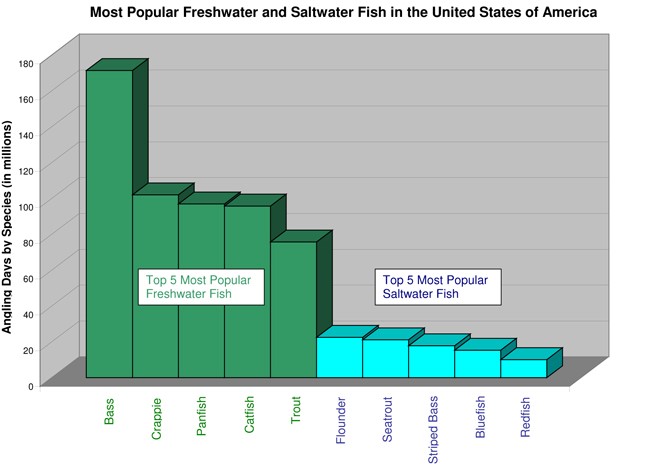
I’m often struck by how frequently recreational and commercial fishermen are pitted against each other over a handful of “popular” fish because they taste good or they fight hard or simply because they are easy to catch. How many fish like sheepshead, once considered less desirable by both recreational and commercial fishermen, are out there? How can fishing for these species lessen the animosity that has been built over fish like red snapper?
I’m also dumbfounded, at times, by the argument that states are not as equipped to manage commercial fisheries as the federal government, especially when states have responded to the increased popularity of sheepshead with adapted management for both recreational and commercial harvest. And still we don’t fight over sheepshead at state commission meetings like we do over red snapper at the federally directed Gulf of Mexico Fisheries Management Council.
State fisheries agencies generally do a good job of conservatively managing commercial and recreational fishing, which is one of the reasons the TRCP and many of its sportfishing partners support the Modern Fish Act—because it would increase the role that states play in federal management and data collection for recreational fishing.

Like sheepshead, there are other fish thought of as trash, simply by reputation. On a late-March trip to Grand Isle, my fishing buddies got to tie into a handful of gafftopsail catfish, another much-maligned, yet hard-tugging and good-eating saltwater predator. I kept the fish, despite some dirty looks, and I used the filets to make a catfish courtbouillon, a rich tomato-based stew my family ate on Good Friday.
Everyone said it was delicious. They had no idea they were eating trash, I guess.
Gafftops, unlike their cousins the hardhead catfish, aren’t bottom-dwelling scavengers. They strike lures as aggressively as redfish and speckled trout and fight every bit as hard. On a memorable day in late August a few years ago, several five-pound gafftops exploded on topwater plugs in the Grand Isle surf when I was aiming for specks. The surface boiled and my drag screamed as if a redfish or big trout had busted the bait. But when the fight was over, my friends looked in disgust at what was on the end of the line. Similar to the way sheepshead were looked at 30 years ago, some of my friends won’t even put a gafftop in the ice chest for fear of scorn at the cleaning table.
But the list of reformed trash fish is growing each year. Bonito were once only kept for cut bait and chum, but if the meat is taken care of, they are just as tasty as their blackfin tuna relatives. Even the dreaded invasive Asian carp is pretty tasty after being dredged in seasoned corn meal and dropped in hot grease. There are more than enough of them available for those who want to give them a taste.
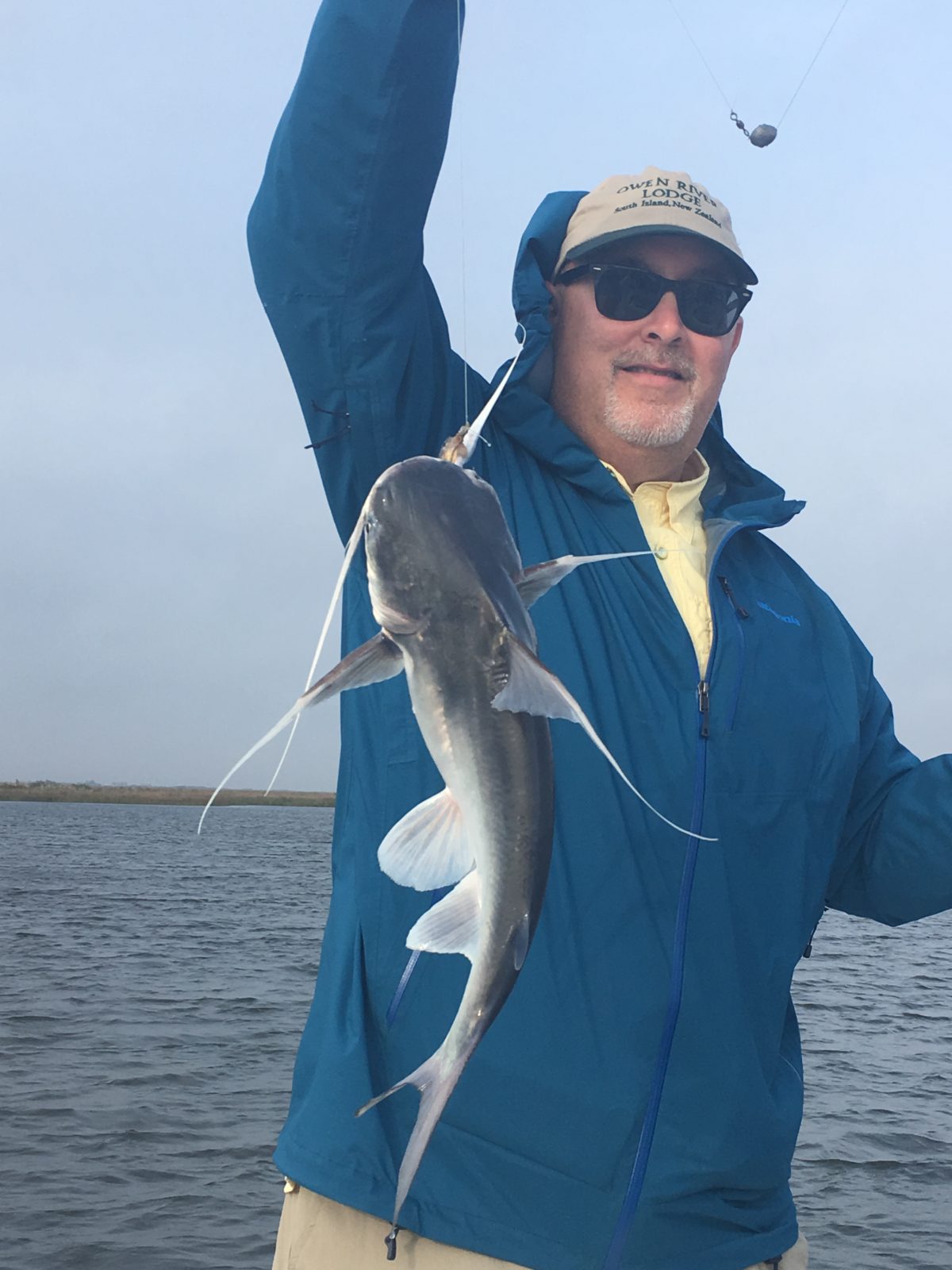
I’m not suggesting that I would give up on a good trout bite or a school of hungry redfish to chase down gafftops or throw chunks of hermit crabs at sheepshead. But, like many fishermen who have busy home- and work-lives, I like to catch something while I’m out there—I’m not going to turn down the opportunity to hook aggressive-striking, hard-pulling fish and keep a few of them for the grill or the fryer.
And I’m not suggesting that improving the management of popular species like red snapper or cobia is less important because there are other fish out there to catch. My point is that, too often, anglers fall into the trap of getting hung up on catching one fish or another, and it can lead to a less enjoyable time on the water if a particular season is closed or the target species doesn’t cooperate that day. It might be up to us to “dig in the trash” more often.
But as attitudes towards these fish evolve and change, it will be even more important that our system of federal fisheries management does not ignore recreational fishing—because restaurant trends will come and go, but the importance of predictable seasons to local outdoor recreation businesses will not.
Top photo by Anna Hesser via Flickr
Whit Fosburgh talks to Mark Kenyon at Wired to Hunt about Farm Bill basics and what’s at stake for habitat conservation and hunting access on private lands
We’re so grateful that podcasters like Wired to Hunt‘s Mark Kenyon are willing to geek out with us about conservation policy when it really matters. Even though we’d all rather be talking about what was on the trail cam yesterday, complex legislation like the Farm Bill will chart a course for the habitat and access projects of tomorrow.
Here are the basics on why it matters and what you need to know as lawmakers write and debate this bill.
Listen for more conservation news and deer hunting stories over at Wired to Hunt.
Anglers who report catch data using the latest apps help fisheries managers adjust seasons in real-time, so why are some still resistant to sharing?
Recreational angler self-reported data has come a long way. As it has suddenly dominated many of the recreational fishery management discussions over the past year, one might think the concept has come out of nowhere. But the Snook and Gamefish Foundation (SGF) has been working on refining the process for almost a decade, and our work has provided some valuable results. The Angler Action Program (AKA iAngler), a service project of SGF, was born in 2010 after an historic cold event severely damaged a host of tropical Florida wildlife, including snook—a native and highly prized gamefish.
In response to the possible crisis, we partnered with Florida’s Fish and Wildlife Conservation Commission to design and build a voluntary self-reporting database that would start to get a handle on just how hard the fishery was whacked by the extreme cold weather. Snook anglers—who range from passionate to completely obsessed—were an easy target for soliciting help.
There were many successes over the following years, most of them ‘firsts’ in the world of fishery management at the state level. After helping with the design of the database and angler survey, FWC left us to run and manage iAngler and its data. Participation was fairly high, with thousands of hours of snook-directed fishing trips reported within months of program initiation. FWC found data useful almost immediately in a few areas, particularly regarding data on the fish we let go, called ‘discards’ by researchers.
Within five years, iAngler was expanded to include all species of fish on a global range, and it was used directly in five different Florida stock assessments for snook, spotted seatrout, and red drum. This is the first time that data collected and managed by anglers was used in a state-level stock assessment.
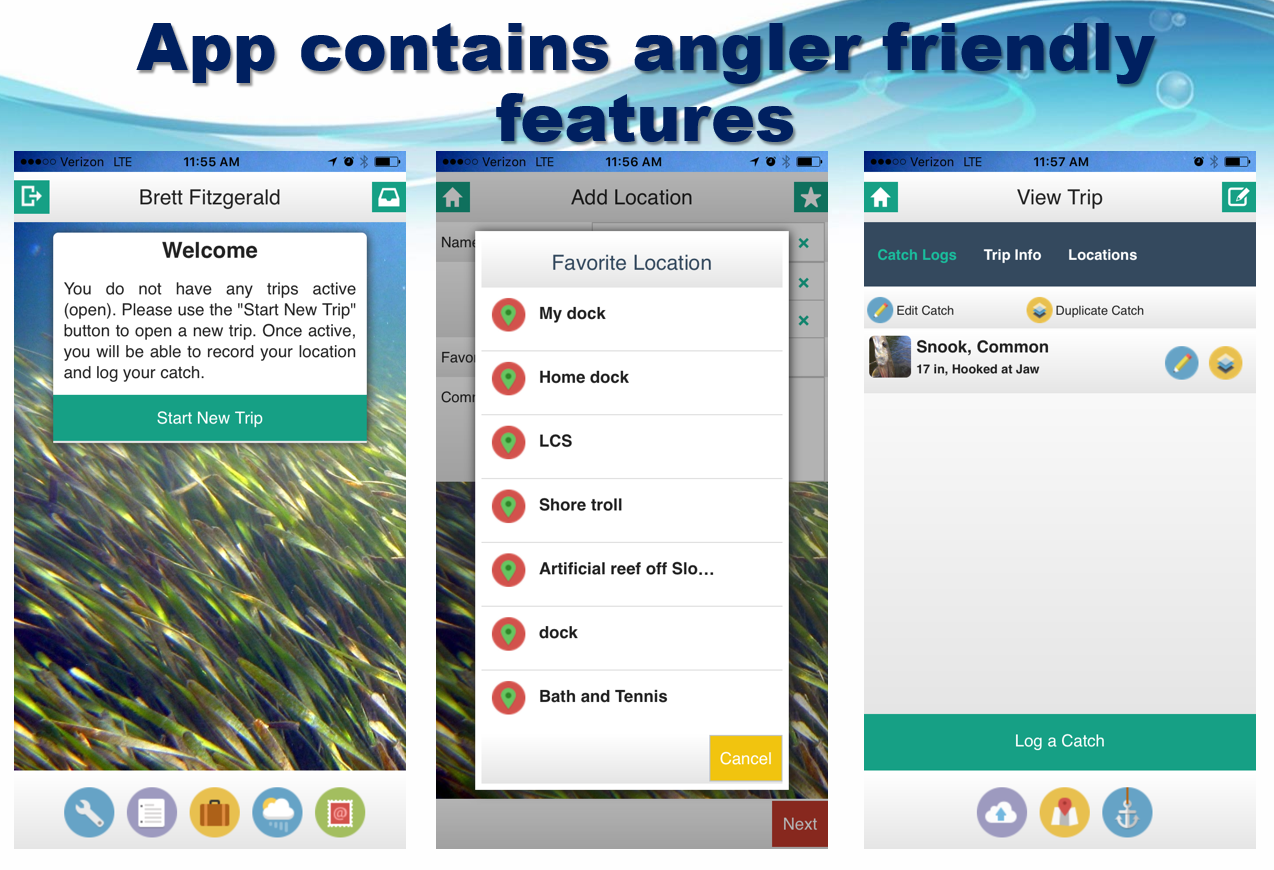
Around that same time, a lab at the University of Florida began running some analysis of iAngler data and comparing it to numbers from the Marine Resources Information Program, which currently collects data for all federally managed fish species. Despite having some design flaws, especially where the program forces commercial models on recreational fisheries, MRIP is responsible for what has long been considered to be the “best available data” for use by federal agencies.
The UF studies focused on how many fish anglers are catching and how big the fish are. This is especially important with discards, as this is an area of fishery information where many species are ‘data poor,’ meaning whatever the best available data is, it ain’t enough.
In general terms, the UF study found that iAngler data in Florida did have some limitations, or biases, however for areas where enough anglers participated the data lined up nicely with MRIP.
Right around the time these very positive results of iAngler data analyses started rolling in, the South Atlantic Fishery Management Council (SAFMC) reached out to SGF to see if we could partner up with the goal of getting a better handle on the Atlantic Red Snapper situation. Similar to the Gulf of Mexico, recreational anglers have been reporting anecdotally that they are experiencing an explosion in the population of this prized fish, yet the season had been closed since 2014 in the South Atlantic because the current data and modeling suggest that the population is still in trouble. Managers understood that there is a problem, but until data collection was improved or at least changed, their hands were mostly tied.
This new partnership led to a reporting tool called MyFishCount, which will allow anglers in the South Atlantic to report their catches – keepers and discards, along with a host of other data points – by this coming summer.
A pilot program was launched during the 2017 Atlantic Red Snapper season, and the results were again very positive. Anglers were able to report a variety of aspects of their planned snapper fishing trips through the system, researchers were able to see the data in real-time, and managers reacted to the data nearly as fast.
For example, the 2017 red snapper season was originally set for six days over two three-day weekends. Through MyFishCount, biologists and managers were able to see that the vast majority of planned fishing trips never took place, because the weather was not favorable for offshore fishing on those dates. Using this information, SAFMC was able to open a third long weekend of fishing.
The point is that anglers were asked to contribute, and because they did, their data was put to immediate good use. In this case, it led to more fishing access.
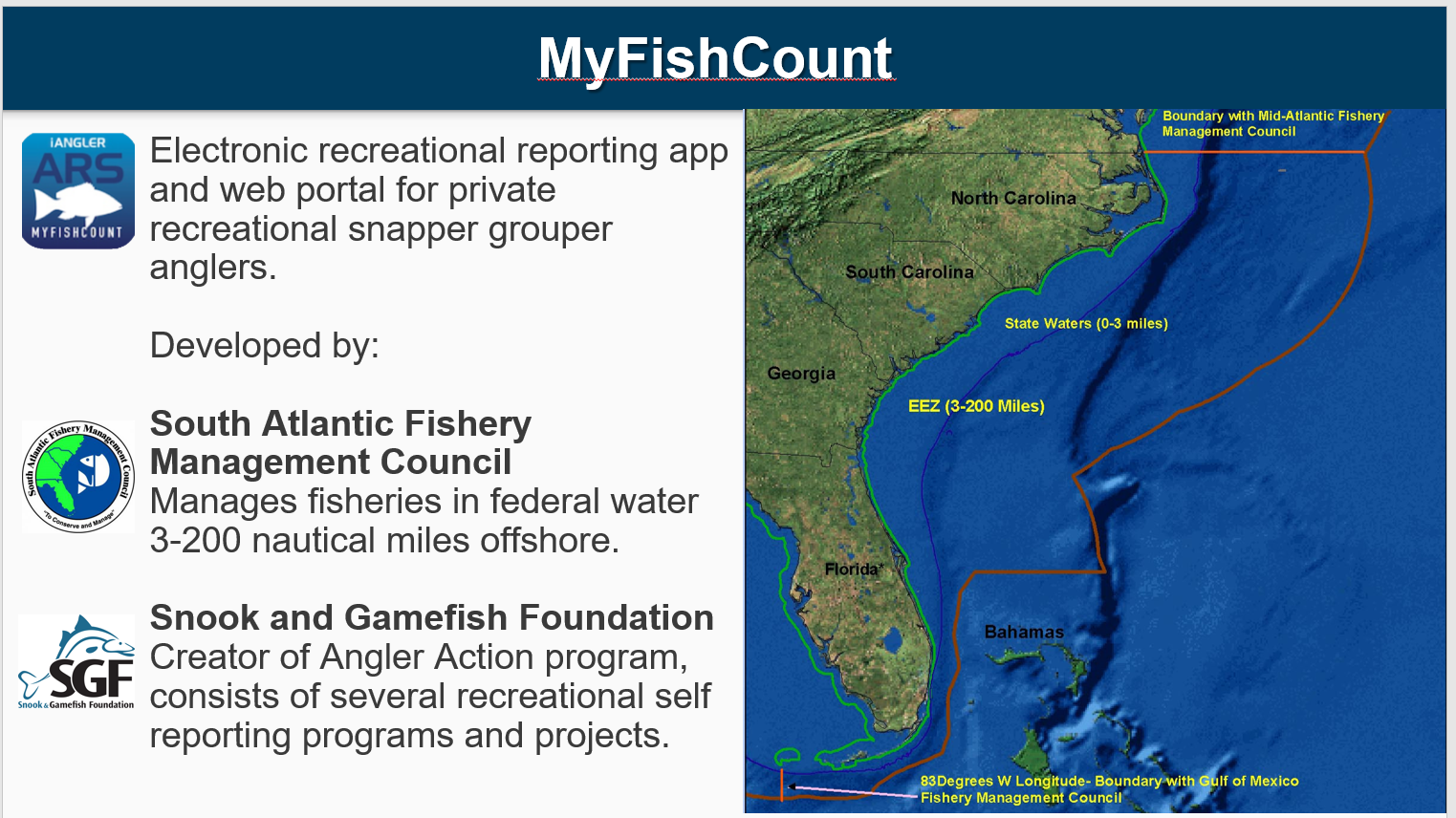
Not for nothing, the weather on that third weekend was pretty horrible, too. But this is ok for anglers: It means that the estimated harvest over the full nine-day fishing season is unlikely to overestimate the fishing effort, which could have led to less access in years to come.
“This is one of the few instances where you have technology, industry, fishermen, and scientists all agreeing on one thing—that we need better data in the recreational fishery—and most of us are seeing a similar approach to reaching that goal,” says Dr. Chip Collier, an SAFMC fisheries biologist who has been involved with the MyFishCount project since its inception.
He and his staff are very excited to have a new and improved version of MyFishCount up and running before summer 2018, and it will be functional for a wide variety of fish species, not just red snapper. “One of the great things about having it ready before the summer is that will be able to show anglers what self-reporting actually looks like,” says Collier. “The ‘fear of the unknown’ can make a lot of people hesitant to take the first step towards getting involved, and this will help.”
“The amount of positive comments we’ve received from anglers who participated has been great, and it feels like it really gives a voice to management,” says Kelsey Dick, SAFMC’s fishery outreach specialist. “I have been very grateful to see people coming together and being supportive of this project.”
The benefits of self-reporting are many. Through this kind of reporting, managers and biologists will get a better understanding of angler behavior on the water.
“We don’t have enough time to interview a lot of recreational anglers, so we don’t really know if people are using descending devices, or circle hooks, or other behaviors.” Dick said.
Mass, real-time self-reported data opens the doors to these types of data streams and that is extremely critical when trying to get a handle on how to best set management rules for a given species in a given region.
For example, in 2017 MyFishCount anglers reported very low use of descending devices or venting tools in shallow water (less than 5%), yet a very high (over 90%) in deeper water. Without the opportunity to self-report behavior like this, Councils have no way of estimating how many anglers are taking extra measures to help ensure fish survive release. And when you are managing ‘data poor’ species such as red snapper, any uncertainty in the modeling usually translates to less access.
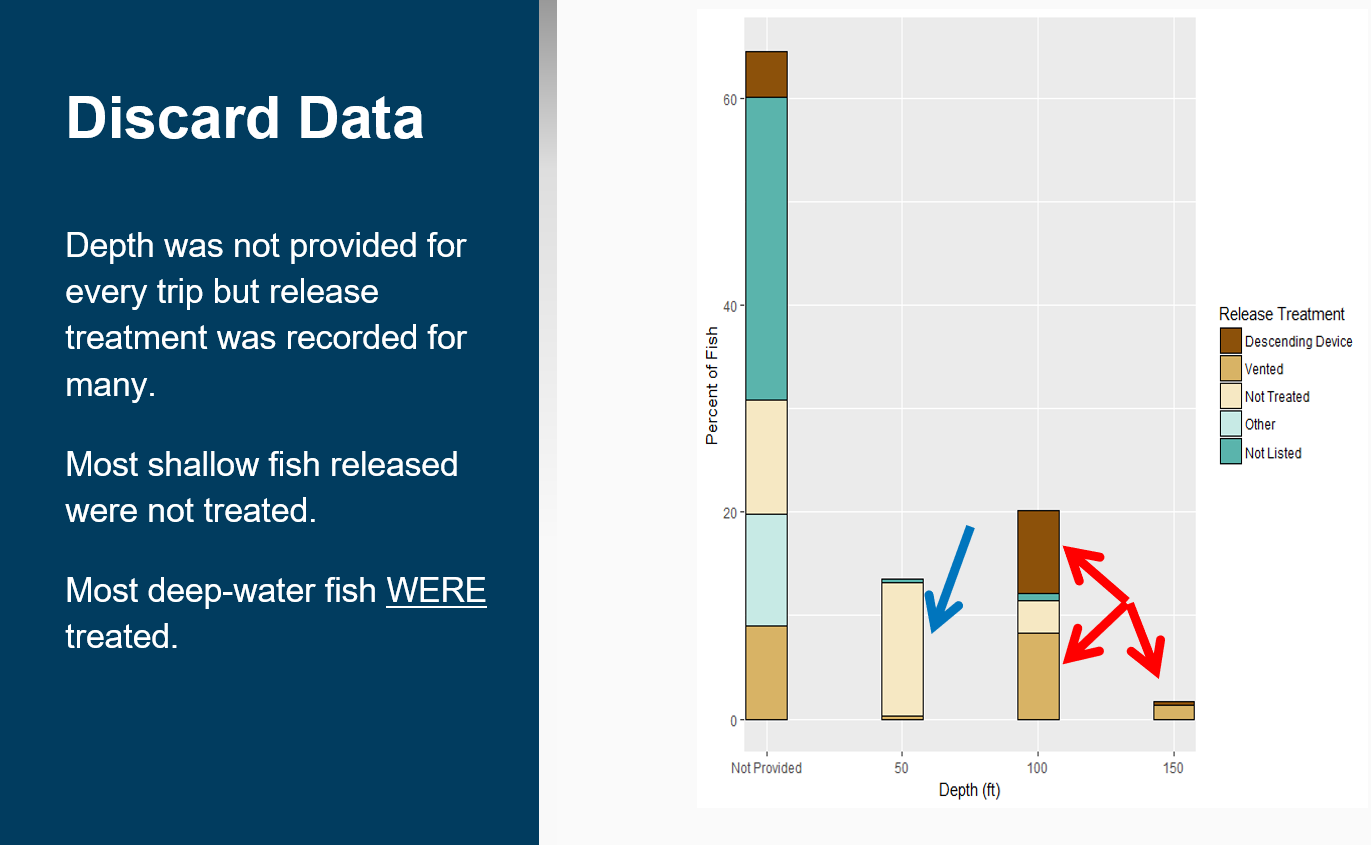
Still, with all indicators pointing in a very positive direction, there is a lot of work to be done, and it is going to take time. “Managing expectations across the board is hard,” says Dr. Collier. Fishermen, scientists, managers and the industry all want this issue solved.
It is going to take some time, but the more anglers that get involved now, the faster we can improve the system and expand the functional uses. This type of data is not yet ready to answer questions like overall effort or fish abundance – researchers first need to understand just how this information represents the fishing community at large. But the mindset has changed greatly over the past couple years, from ‘the data is no good’ to ‘we must understand and measure biases in data, then account for those biases.’ This is an extremely encouraging trend.
The Snook and Gamefish Foundation is working with The American Sportfishing Association, Theodore Roosevelt Conservation Partnership and a host of other conservation and fishing industry groups, state and federal agencies to explore ways to better integrate self-reported data the use of technology to improve fisheries management.
Management is going to happen whether the data improves or not. So getting involved and reporting through iAngler now, no matter where you are, is a very important step for recreational anglers. It not only allows you to contribute immediately to a brighter fishing future, but also to keep tabs on how the technology is changing fishing behavior and management so you can help shape the direction in the future.
Brett Fitzgerald is the Executive Director of the Snook and Gamefish Foundation. He is also a contributing editor to Florida Sportsman Magazine, and a special education instructor in the Palm Beach County school system for where he promotes an academic curriculum through environmentalism and resource conservation. Fitzgerald is an avid guitar player, fly tyer, photographer and fisherman.
A new certificate program in Montana helps hunters understand more about conservation, ethics, and respect for private land in order to gain access to more of it
Asking permission to hunt on someone’s land is a vulnerable proposition. There’s a tremendous upside for your access close to home, but it all depends on the landowner taking a bet on you, your skills, and how you’ll treat their property. And we all know that one bad actor can make this ask even more challenging for others.
That’s why a Montana non-profit with an eye toward improving sportsman-landowner relations and hunting access has created a program to certify sportsmen and women that they can vouch for with private landowners—some of whom have never opened their gates to hunters before.
“Landowners might not know what they’re going to get—it really makes a difference when someone comes to your property with an understanding of your needs, respect for your land, and respect for the wildlife,” says George Bettas, project coordinator for One Montana’s new Montana Hunter Advancement Program, which was created to promote safe, ethical, and responsible hunting on enrolled private lands through its Master Hunter certification course. “Our goal is to send out skilled, ethical hunters who landowners know they can trust, to hopefully create new opportunities on properties that have provided little to no access for hunters in the past.”
The certification program has a core curriculum with three parts: A history of conservation and hunting ethics, a section on the value of agriculture and the landowner’s perspective, and a field session for testing and improving competency with a rifle or bow. They will accept 30 applicants into the pilot course for rifle hunters this spring. The cost is $200, which covers a weekend worth of instruction, ammo, provided lunches, and facilities—but scholarships are available. Program leaders are looking for a diverse range of ages, backgrounds, and skill levels for the pilot course.
Part of the process is generating an awareness of a visiting hunter’s impact on the farm or ranch, and what kinds of activities may be happening on private land at certain times of year. Bettas hopes this will help create a bond between landowners and sportsmen, who will know enough to avoid crossing freshly seeded winter wheat or tearing up an access road with tire chains just to get closer to a downed animal. He believes more educated, ethical hunters are less likely to put themselves in danger, take a shot where they can’t recover the animal, or give up on a critical contract with the landowner—to help manage wildlife that damage crops or property.
“I’m confident that when we send the first 30 graduates out to hunt the available properties, they will be great ambassadors for hunting, and the landowners are going to want them back again,” says Bettas.
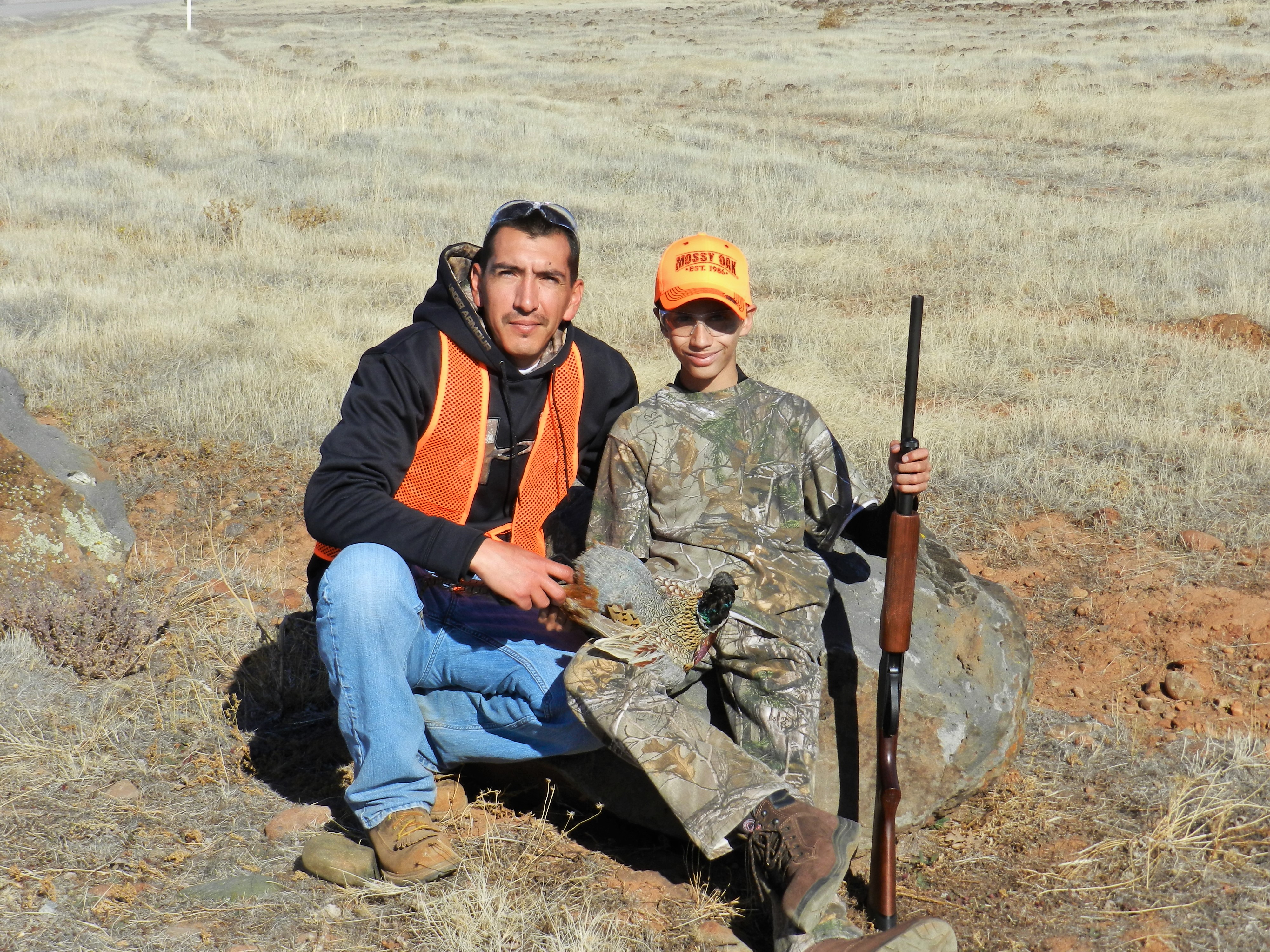
Certified Montana Master Hunters will be able to access an online reservation system for enrolled properties made possible by Huntable.com, an Airbnb-like service that allows landowners to approve certain dates and know who is going to show up when.
There has been some criticism on the group’s Facebook page about the course being “elitist,” but Bettas stresses that anyone with some hunting experience can apply and potentially receive assistance with the fee. “Overall the response has been tremendous, and we hope to eventually make some of the coursework available online for anyone who is interested,” he says.
With the decline in hunter participation and a wave of out-of-state and urban buyers taking over properties that have traditionally been open to hunting and fishing, sportsmen’s access and landowner certainty about who they are letting use their property are as critical as ever in Montana. The TRCP has been supportive of the Hunter Advancement Program and certificate course, because it enhances access, promotes conservation ideals, and helps to retain active hunters who keep the $887-billion outdoor recreation economy flourishing. And farmers and ranchers who believe the best of hunters and anglers can often have an outsize impact on the health of fish and wildlife habitat, too.
Of course, you don’t need to be certified to build a relationship of mutual respect with a private landowner. But it’s pretty cool to see this example of a solution that brings both sides together to find common ground.
Montana residents can apply for the program here until April 1. For the pilot course, just 30 rifle hunters will be selected, and scholarships are available. Visit mtmasterhunter.com for details and to watch for future courses.
Theodore Roosevelt’s experiences hunting and fishing certainly fueled his passion for conservation, but it seems that a passion for coffee may have powered his mornings. In fact, Roosevelt’s son once said that his father’s coffee cup was “more in the nature of a bathtub.” TRCP has partnered with Afuera Coffee Co. to bring together his two loves: a strong morning brew and a dedication to conservation. With your purchase, you’ll not only enjoy waking up to the rich aroma of this bolder roast—you’ll be supporting the important work of preserving hunting and fishing opportunities for all.
Learn More
